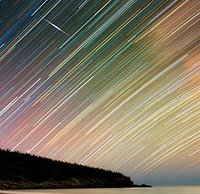Capturing the perfect Perseids photo: Tips and tricks for helping you turn those meteors into a masterpiece
posted Thursday, August 11, 2016 at 9:57 AM EST

"The Perseids show up every year in August when Earth ventures through trails of debris left behind by an ancient comet," says NASA. This year might be a particularly good year for viewing the fast, bright meteors streak across the night sky because we are in for a closer encounter than usual. In fact, meteors might be shooting across the heavens at twice the normal rates tonight. Bill Cooke, of NASA's Meteoroid Environments Office in Huntsville, Alabama, estimates that with ideal conditions, viewers could see up to 200 meteors per hour. These meteors are small pieces of the Swift-Tuttle comet, and August is when Earth travels through this debris. For more information on the comet and how best to view the Perseids, see here.
What about doing more than just observing? For photographing the meteor shower, what do you need? If you're an Olympus shooter, you're already well-equipped due to their camera's Live Composite feature. Some of the capable cameras include the OM-D E-M1, OM-D E-M5 Mark II and recent PEN-F. Olympus has made a video, seen below, to help you learn how to use Live Composite for night photography. Additionally, along with Peter Baumgarten, Olympus has tips for astrophotography, which you can apply to your Perseid photographs.
For both Olympus and non-Olympus shooters, 500px also published a selection of tips from Thomas O'Brien for photographing for tonight's meteor shower. Firstly, you want to find a location that is far away from light pollution, or at least as far away as you can get. You can use this website to help find the darkest skies near you. When you've found a good spot, set up and use a sturdy tripod. Set your lens to its maximum aperture, grab some sort of remote cable release (preferably wired) and manually focus your lens to infinity. To see the rest of O'Brien's tips and his gear list, read the article at 500px.
If possible, go out and scout locations during the day so that you can evaluate your composition options. In my experience it's very difficult to set up your frame at night, and you will spend a lot of time doing so. If you need to test focus or composition at night, don't hesitate to increase your ISO to very high levels so that you have to spend less time making exposures, just don't forget to turn it back down when you want to start capturing usable photos. You can see a very cool video O'Brien made of meteors below.
For more tips and tricks on photographing meteors, see the list of articles below:
"How to Photograph Meteors with a DSLR" by Mike Hankey for American Meteor Society
"Capturing the Perseids: How to Photograph a Meteor Shower" by Jerry Lodriguss for Sky & Telescope
"How to Photograph Tonight's Perseids Meteor Shower" by Chris Rowlands for Stuff.tv
One thing that is very much out of your control is weather, more specifically cloud cover. You can use this site to check the cloud cover forecast for your area.
Readers, do you have any tips and tricks for shooting meteor showers that you'd like to share? Do you plan to go out tonight and grab some Perseids photos? Let us know in the comments below!
